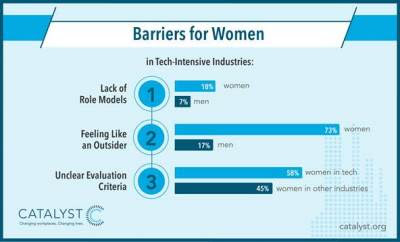Catalyst's Global Report Uncovers New Layers of Inequity for Women in STEM Industries
It’s no secret that women in tech roles in STEM—the science, technology, engineering and math industries—face significant challenges. Catalyst’s groundbreaking new global report, High Potentials in Tech-Intensive Industries: The Gender Divide in Business Roles, shows that those on the business side are impacted too, and it reveals a culture that is particularly unwelcoming to women, no matter what the job.
This research is the first to study men and women in business roles in technology-intensive industries such as high tech and telecommunications, oil and gas, and automotive manufacturing. It shines a light on the male-dominated culture of STEM companies as a whole and provides specific steps organizations can take to better attract and retain talented women across both its tech and business sectors.
“STEM companies face a serious talent drain as women take their skills elsewhere, but these organizations also have a remarkable opportunity to turn things around by focusing on how they can make all their talent—men and women alike—feel equally valued,” says Deborah Gillis, President and CEO, Catalyst.

Key Findings:
Women are less likely to enter tech-intensive industries and more likely to leave once they join.
Catalyst offers concrete suggestions and action steps for reversing the talent drain:
This research is the first to study men and women in business roles in technology-intensive industries such as high tech and telecommunications, oil and gas, and automotive manufacturing. It shines a light on the male-dominated culture of STEM companies as a whole and provides specific steps organizations can take to better attract and retain talented women across both its tech and business sectors.
“STEM companies face a serious talent drain as women take their skills elsewhere, but these organizations also have a remarkable opportunity to turn things around by focusing on how they can make all their talent—men and women alike—feel equally valued,” says Deborah Gillis, President and CEO, Catalyst.

Key Findings:
Women are less likely to enter tech-intensive industries and more likely to leave once they join.
- Only 18% of women opted for a business role in a tech-intensive industry immediately following their MBA, compared to 24% of men.
- 53% of women who started out in a business role in a tech-intensive industry post-MBA left to take a position in another industry, compared to 31% of men.
- Despite having the same education as their male counterparts, women in business roles in tech-intensive industries were more likely than men to start in entry-level positions (women, 55%; men, 39%) and to be paid less.
- Of those who took their first post-MBA job in a business role in a tech-intensive industry, men were more than three times as likely (83%) as women (27%) to say they felt similar to most people at work.
- High potentials who took their first post-MBA job in a business role in a tech-intensive industry were significantly more likely to work on a team with 10% or few women than those in other industries (tech-intensive industries, 21%; other industries, 16%).
- High potentials were significantly less likely to have a female supervisor than those working in other industries (tech-intensive industries, 15%; other industries, 21%).
- Women in tech-intensive industries were significantly less likely than women in other industries to say that their supervisors clearly showed them how their work would be evaluated (tech-intensive industries, 42%; other industries, 55%).
- Women in their first post-MBA job were less likely than men to aspire to the senior executive/CEO levels (women, 84%; men, 97%).
Catalyst offers concrete suggestions and action steps for reversing the talent drain:
- Start men and women at equal levels and pay.
- Evaluate company culture: Is hostile behavior toward women tolerated? Do events outside of the office exclude women? Consider how the organization can make women feel valued and included.
- Recruit senior male executives to sponsor up-and-coming women.
- Make performance standards crystal clear.
- Provide a flexible work environment.

Comments